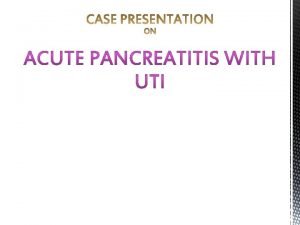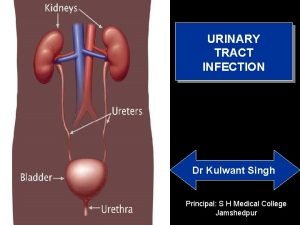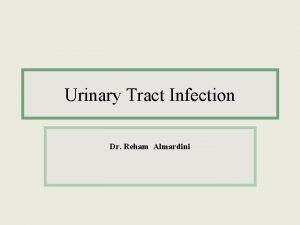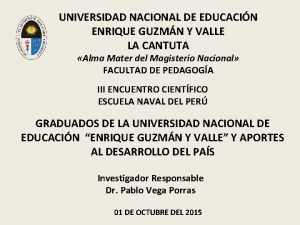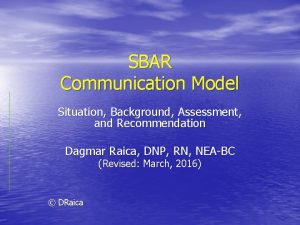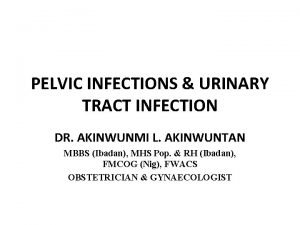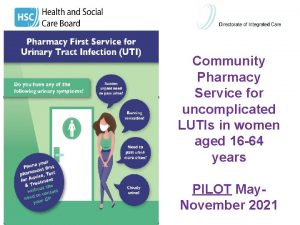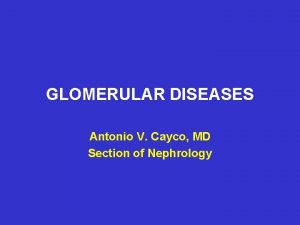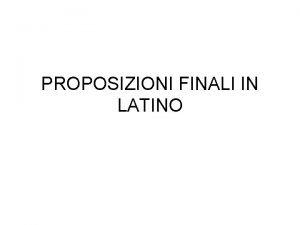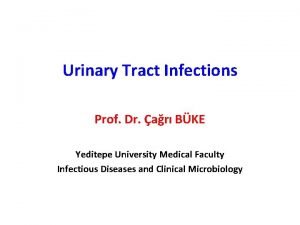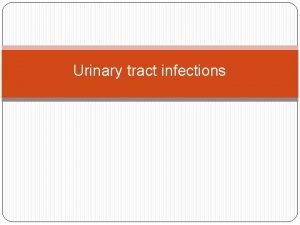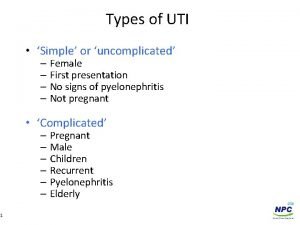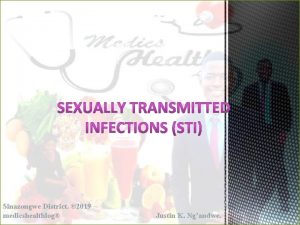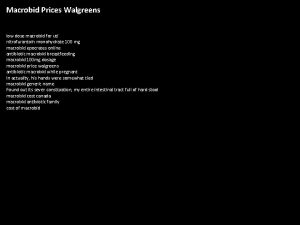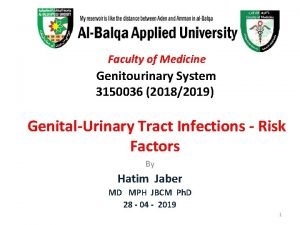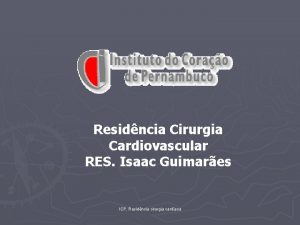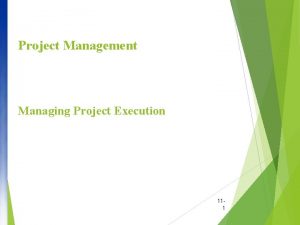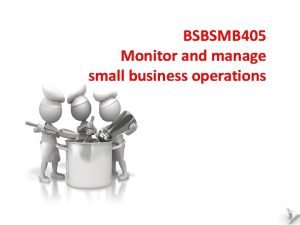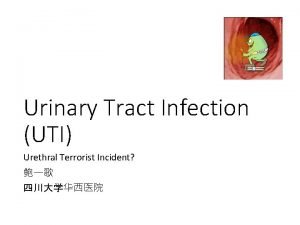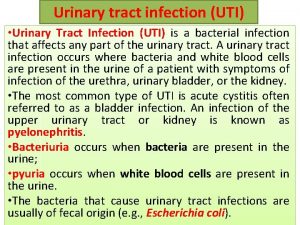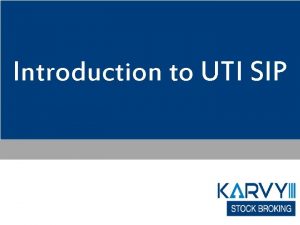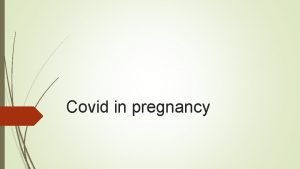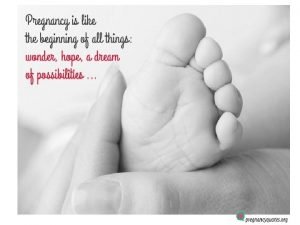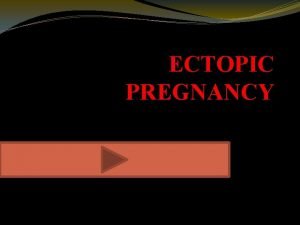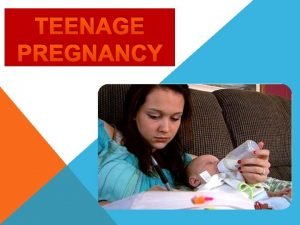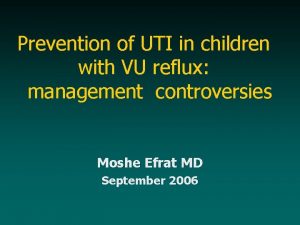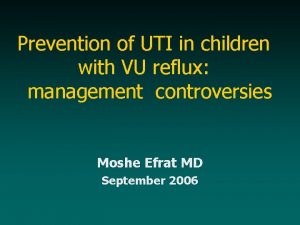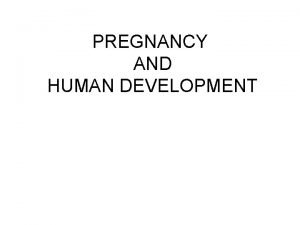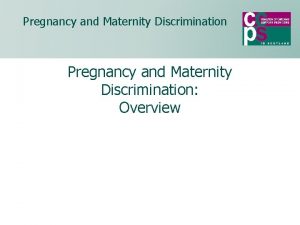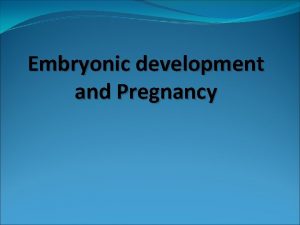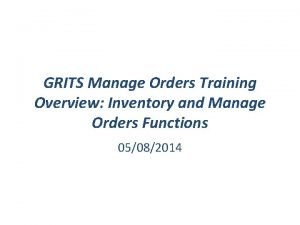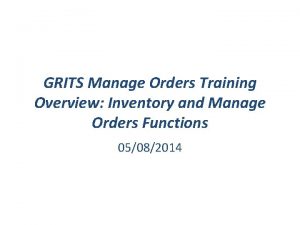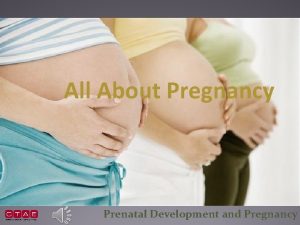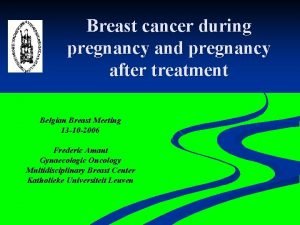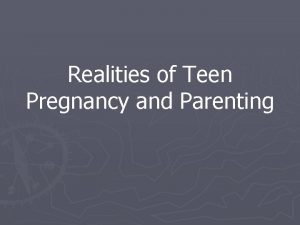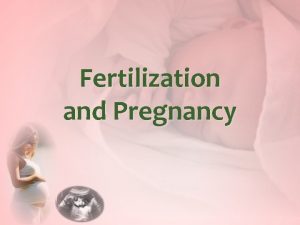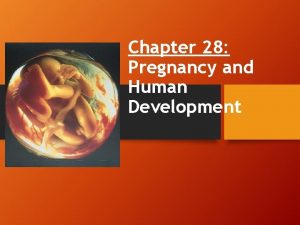How to Manage UTI in Children and Pregnancy































- Slides: 31

How to Manage UTI in Children and Pregnancy SANG DON LEE PUSAN NATIONAL UNIVERSTIY

Contents l Management of UTI in Children Based on Pathophysiology l Management of UTI in Pregnancy

Pathophysiology Finer G, et al. Lancet Infect Dis 2004; 4: 631 -5

UTI vs VUR and Renal scar l VUR: the most common, 21 -57% l Renal scar: 40 -73% in UTI with VUR Pediatrics, 1999; Hodson CJ, BMJ 1965; Rushinton J Urol 2002

VD, Constipation vs UTI Bladder Dysfunction Incontinence VUR Mucosal Ischemia UTI Constipation Pelvic-floor Dysfunction Overtraining of Pelvic-floor muscle Milk-back Residual urine UTI Scand J Urol Nephrol 2002; 36: 260 -7

Constipation, OAB vs UTI l Close relationship between recurrent UTI and constipation ü Neumann et al, Pediatrics 1973; 52: 241 -5 ü O’Regan et al, Clin Nephrol 1985; 23: 152 -4 l Close relationship between recurrent UTI, constipation and OAB ü Hellstein S et al, Clin Pediatr 2003; 42: 43 -9 Constipation UTI OAB

Voiding dysfunction SUI Hinman Voiding SD Dysfunction Overactive Bladder Enuresis Risoria Lazy Bladder SD

VD, Constipation, OAB vs UTI

Relationship between VUR, VD constipation, OAB and UTI OAB UTI Constipation Milk back of infected urine Effects on local defence mechanism Increased post-void rediduals VUR Voiding Dysfunction Change in bladder sensation

Why does UTI in children needs to manage ? Shortliffe LMD, Campbell’s Urology 2002

J Urol 2006; 175: 989 -93

General Principles of Treatment OAB UTI Constipation Milk back of infected urine Effects on local defence mechanism VUR Increased post-void rediduals Voiding Dysfunction Change in bladder sensation

Principle of voiding dysfunction Breakage of Vicious Cycle Pharmacotherapy Posture Correction Tx for Constipation Bladder Dysfunction Incontinence VUR Mucosal Ischemia UTI Pharmacotherapy Voiding & drinking chart Intravesical Biofeedback Constipation Pelvic-floor Dysfunction Overtraining of Pelvic-floor muscle Relaxation Biofeedback Uroflow Biofeedback Pharmacotherapy Milk-back Residual urine UTI Scand J Urol Nephrol 2002; 36: 260 -7

Management of Constipation l Relief of Pain on defecation Breakage of Vicious cycle l Fiber diet l Encourage Fluid Intake l Go to stool whenever feel sense of defecation l Posture correction l Pelvic floor relaxation l Mineral oil, Sorbitol, Mg, Laxatives l Enema l Suppositories

Major Treatment Modalities for OAB l Behavioral therapy l Pharmacotherapy ü Oral ü Intravesical l Neuromodulation ü Electrical ü Magnetic ü ü ü l Surgical therapy ü Noninvasive ü Invasive Campbell’s Urology 9 th ed; BJU Int 001; 87: 723 -31 Anticholinergics Antimuscarinics Alpha antagnoists UTI control Constipation control

Treatment algorithm by the AAP (1999)

Conclusions: Pediatric UTI (1) l UTIs in children often go undiagnosed since the signs & symptoms are usually non specific and overlap with other common childhood illnesses. l We need to understand the pathogenesis of UTIs and the relationship between UTIs, VUR, voiding dysfunction & OAB. l Prompt management of UTIs & its’ underlying causes in children is required to reduce morbidity, long-term complications & improve outcomes.

Conclusions: Pediatric UTI (2) l Voiding dysfunction & UTI & OAB in children may be treated without accurate evaluation of bladder, urethral, bowel function. However it would require a longer treatment than necessary with the possibility of trial and error. l Evidence based proper Tx can promise to prevention of the disease progression into adulthood. l To accomplish high success rate of treatment, multidisciplinary & comprehensive Tx is mandatory.

Contents l Management of UTI in Children Based on Pathophysiology l Management of UTI in Pregnancy

Pathogenesis and UT changes l Organisms bacteriuria are similar in both thecausing incidence of bacteriuria in pregnant l Although pregnantisand nonpregnant women similar to that in their nonpregnant counterparts, the incidence of acute pyelonephritis in pregnant women with bacteriuria is significantly increased, compared with nonpregnant women. l. Anatomic and physiologic urinary tract changes in pregnancy may cause pregnant women with bacteriuria to have an increased susceptibility to pyelonephritis. Obstet Gynecol Clin North Am 2001; 28: 581– 91 Infect Dis Clin North Am 1997; 11: 13– 26 J Urol 1981; 125(3): 271– 6

Significance of ASB l If untreated, as many as 20 -40% of pregnant women with ASB will develop PN. l Treatment of bacteriuria early in pregnancy has been shown to decrease the incidence of PN by 90%. l In various studies, untreated bacteriuria has been linked with prematurity, low birth weight, intrauterine growth retardation, and neonatal death. Urol Clin N Am 2007; 34: 35, Infect Dis Clin North Am 1997; 11: 593, Infect Dis Clin North Am 1997; 11: 13, Am J Public Health 1994; 84: 405

Treatment of ASB l Screening and Tx for ASB significantly decreases the risk of symptomatic UTI and its complications. l Tx of ASB decreases the incidence of PN during pregnancy from 13. 5 -65% down to 5. 3 -0%. l The Tx duration varies from a single dose to one week. l Cure rates of single dose & 3 -day Tx: 50 -60% & 70 -80%. l Cure rates do not improve with longer courses of therapy and thus, 3 -day therapy is recommended. l A follow-up culture 1 week following Tx should be obtained. l In 20 -30% of patients, short-course Tx will fail. ü a repeat 7 -10 day culture-specific Tx is appropriate. Urol Clin N Am 2007; 34: 35, Infect Dis Clin North Am 997; 11: 13, Br J Obstet Gynaecol 1983; 90: 1054, Urol Clin North Am 1975; 2: 485, N Engl J Med 1993; 329: 1328, Semin Perinatol 1977; 1: 25,

Prevention of ASB l After a negative culture is obtained, daily antimicrobial suppression should be considered. ü Without prophylaxis, as many as one third of women will experience recurrent infections during pregnancy. l If suppression is not used following Tx of ASB, women should have frequent urine cultures throughout the remainder of pregnancy to identify recurrent bacteriuria. l In women with recurrent or persistent bacteriuria, follow-up cultures should also be obtained after delivery. Additionally, a urologic evaluation 3 to 6 months postpartum is appropriate. Obstet Gynecol Clin North Am 2001; 28: 581, Infect Dis Clin North Am 997; 11: 13, Infect Dis Clin North Am 2003; 17: 367, Clin Infect Dis 1992; 14: 810, J Reprod Med 1986; 31: 23

Treatment of cystitis in pregnancy l Treatment of cystitis is the same as treatment for ASB. l Follow-up is important because up to one third of women may experience recurrent UTI during pregnancy. Urol Clin N Am 2007; 34: 35

Significance of PN: Complications l Fetal complications ü Preterm labor, prematurity, low birth weight ü Intrauterine growth retardation, neonatal death l Maternal complications ü Anemia, hypertension, transient renal failure ü Acute respiratory distress syndrome, sepsis Obstet Gynecol Clin North Am 2001; 28: 581, Clin Obstet Gynecol 1993; 36: 855, Am J Obstet Gynecol 1981; 141: 709, Urol Clin N Am 2007; 34: 35

Treatment of PN (1) l All patients who have PN during pregnancy should be admitted and treated with parenteral agents. l Initial AB Tx is typically ampicillin plus gentamicin or cephalosporins. ü 2 nd or 3 rd generation cephalosporins may also be considered for single-agent Tx. ü With these Tx regimens, more than 95% of women will respond within 72 hours. l Resistant organisms must be considered in women who do not respond appropriately to Tx, and antimicrobials should be changed according to culture results. Obstet Gynecol Clin North Am 2001; 28: 581, Obstet Gynecol 1973; 42: 112, Am J Obstet Gynecol 1995; 172: 129, Campbell’s Urology. 8 th ed 2002, 516, Urol Clin North Am 1999; 26: 779

Treatment of PN (2) l If Tx response is suboptimal despite culture-specific Tx, an ultrasound should be obtained to rule out nephrolithiasis, structural abnormality, or renal abscess. l Once afebrile, women may be switched to a 2 -week outpatient course of an oral antimicrobial. l This course should be followed by suppressive Tx until delivery. l As with ASB and cystitis, follow-up after Tx is important. l Women should be monitored closely throughout their pregnancy because there is an increased risk of recurrent PN. South Med J 1984; 77: 455, Scand J Infect Dis 1991; 23: 221 Am J Obstet Gynecol 1981; 141: 709, Urol Clin N Am 2007; 34: 35

Antimicrobials in pregnancy

Summaries: Pregnancy UTI l Urine culture is the gold standard for screening for bacteriuria in pregnancy. l All pregnant women should be screened for bacteriuria in the first trimester. l Women with a history of recurrent UTI or urinary tract anomalies should have repeat bacteriuria screening throughout pregnancy. l All bacteriuria should be treated during pregnancy. l Treatment should be effective, and nontoxic to the fetus. l Antimicrobial prophylaxis or close follow-up after treatment of ASB and symptomatic UTI is necessary throughout the remainder of pregnancy.

Conclusions: Pregnancy UTI l UTIs are common complications of pregnancy and may lead to significant morbidity for both mother and fetus. l During pregnancy, ASB is the major risk factor for developing a symptomatic UTI. l Screening and Tx of pregnant women for ASB may prevent morbidity associated with symptomatic UTIs. l Bacteriuria should be treated with short-course Tx with appropriate antimicrobials. l Women should be followed closely after Tx of bacteriuria because recurrence may occur in up to one third of patients.

Thank you for your attention ! “The Free UTI Makes The Happiness”
 Molar pregnancy
Molar pregnancy Pancreatitis and uti
Pancreatitis and uti Uti upper and lower
Uti upper and lower Peylonephritis
Peylonephritis Hominem uti hominem educare oportet
Hominem uti hominem educare oportet Sbar examples for nursing students
Sbar examples for nursing students Hana dujmović
Hana dujmović Uti discharge pictures
Uti discharge pictures I am safe checklist
I am safe checklist Bso uti pilot
Bso uti pilot Uti swatantra
Uti swatantra Icici
Icici Vcayco
Vcayco Proposizioni in latino schema
Proposizioni in latino schema Utiitsl objection menu
Utiitsl objection menu Uti posidetis juris
Uti posidetis juris Risk factors uti
Risk factors uti Ua uti results
Ua uti results Complicated uti symptoms
Complicated uti symptoms Complicated uti symptoms
Complicated uti symptoms Causes of a uti
Causes of a uti Uti discharge pictures
Uti discharge pictures How much does macrobid cost
How much does macrobid cost Uti causes
Uti causes Complicated vs uncomplicated uti
Complicated vs uncomplicated uti Utiitsl psa login
Utiitsl psa login Atalectasias
Atalectasias Pregnancy and infant cohort monitoring and evaluation
Pregnancy and infant cohort monitoring and evaluation 111 project
111 project Cash budget benefits
Cash budget benefits Sources of information on professional development trends
Sources of information on professional development trends Bsbsmb405
Bsbsmb405

